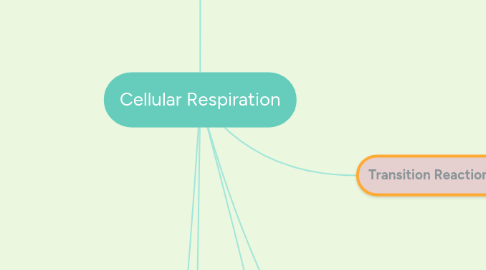
1. Electron Transport Chain: Final Stage
1.1. A series of molecules that transfer electrons from molecule to molecule
1.1.1. Electrons from all NADH and FADH2 are harvested and passed along ETS by electron carriers
1.1.2. Electron carriers used to move electrons
1.1.2.1. Cytochromes
1.1.2.2. Flavoproteins
1.1.2.3. Iron-Sulfur Proteins
1.1.2.4. Ubiquinones
1.1.3. Electrons passed along from carriers with most negative to most positive redox potential
2. Chemiosmosis
2.1. Flow of protons through ATP synthase
3. Oxygen: Terminal electron acceptor (most positive redox potential)
3.1. Oxygen molecule gains electrons from final protein in the chain and is reduced to H2O
4. ATP synthase
4.1. Acts as a channel protein, helping hydrogen ions across membrane
4.2. Acts as an enzyme, forming ATP from ADP and inorganic phosphate
5. Glycolysis:First Stage
5.1. Function: Breaks down glucose
5.1.1. Start: 6-Carbon glucose molecule 2 NAD+ 2 ATP
5.1.1.1. 6-Carbon glucose molecule
5.1.1.1.1. 2 G3P
5.1.1.2. 2 NAD+
5.1.1.2.1. 2 NADH
5.1.1.3. 2 ATP
5.1.1.3.1. 4 ATP (2 used, net: 2 ATP)
5.1.2. End: 2 3-Carbon Pyruvates 2 NADH 4 ATP (net: 2)
6. Transition Reaction(bridge reaction)
6.1. Function: Prepare Pyruvate for next oxidative pathway
6.1.1. 3-Carbon Pyruvate
6.1.1.1. NAD+ ---> NADH
6.1.1.2. 1 Carbon lost to CO2 (decarboxylation)
6.1.1.3. Attached to carrier coenzyme A
6.1.1.4. Oxidation
6.1.2. 3-Carbon Pyruvate
6.1.2.1. NAD+ ---> NADH
6.1.2.2. 1 Carbon lost to CO2 (decarboxylation)
6.1.2.3. Attached to carrier coenzyme A
6.1.2.4. Oxidation
6.2. End results: 2 acetyl-CoA molecules 2 NADH+CO2
7. Krebs Cycle: Second Stage
7.1. Function: To form electron carriers for ETC and complete breakdown of Carbon from original glucose into CO2
7.1.1. Start: 2 acetyl-CoA molecules 6 NAD+ 2 FAD
7.1.1.1. Cycle 2x
7.1.1.1.1. acetyl-CoA molecule---->2-Carbon acetyl group
7.1.1.1.2. Acetyl group donated to 4-Carbon oxaloacetate, forming Citrate
7.1.1.1.3. Citrate oxidized, releasing two CO2 molecules
7.1.1.1.4. 3 NAD+ ----->NADH/H+
7.1.1.1.5. FAD----->FADH2 (reduced electron carrier)
7.1.1.1.6. ADP ---> ATP (substrate-level phosphorylation)
7.1.1.1.7. O2 -----> H2O
7.1.1.1.8. Regenerate Oxaloacetate
7.1.2. Products: 6 NADH 2 FADH2 4 CO2 2 ATP 2 H2O
